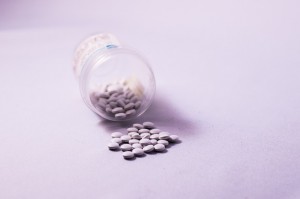3 Ways Health 2.0 Will Revolutionize Doctor/Patient Communication (Part 3)

The road so far: Health 2.0 describes the integration of modern, nonintrusive, user-friendly medical technology into the day-to-day lives of the average person. This has come to fruition in the form of virtual doctor’s appointments online, where basic ailments can be diagnosed and treatments prescribed. It also manifests in the market for personal fitness monitoring devices, like FitBit and Nike Fuel bands, which collect and store information on how much exercise the wearer gets, their resting heart rate, and how well they’re sleeping. We even met BitBite, which claims it will soon be able to tell how many calories are in your food, count your bites, and store the stats in your smartphone.
3. Your Own, Personal “Check Engine” Light
With technology like FitBits and BitBites coming online alongside Bluetooth headsets and Smart watches, you could be forgiven for wondering how many little plastic sensors you’re expected to strap on at any given time. There must be an easier way, right?
Well, there is – or there will be soon – but there’s a catch: you’re going to have to swallow it.
Proteus Digital Health is pioneering this technology, in the form of a micro-sensor the size of a pinhead, embedded in a placebo pill. You swallow it and the pill dissolves, while the sensor takes up residence in your gut. The thing has no power source; rather, it charges on contact with your stomach acid. And once it’s there, it transmits data on activity, heart rate, sleep patterns, and respiration to a patch you wear under you clothing. The patch, larger than the sensor and battery-powered, then transmits the data to your smartphone via Bluetooth, for review on an app.
In addition to monitoring your vitals, this internal sensor also picks up on the type and level of medication that might be in your system. The immediate application is to detect whether you’ve taken your medication daily, and send a reminder to your phone if you didn’t. It can also track trends over time – do you take your meds the same time every day? How often do you miss pills? Your doctor can then review this information, and adjust your treatment accordingly. This technology is expected, in the short term, to help people who take a lot of medication keep track of what they’ve taken, as well as providing physicians honest data in cases where medication is necessary for the patient’s safety.
In the long term, the possibilities seem endless. Imagine having a heart attack or stroke, or losing consciousness, but your internal sensor detects it and alerts you before the worst hits. Imagine a sensor that could assess the nutritional value, or lack thereof, of everything you ingest, and give you a daily report, or a breakdown of each meal. How about one that could detect the kind of internal anomalies caused by early-stage cancer, and alert you to see an oncologist?

Theoretically, a device like this could even take independent action in response to the data it collects – with your permission, of course. What if the sensor contained and dispensed medication in response to stimuli from your body – aspirin if your have a heart attack, or an appetite suppressant once you hit a set limit of daily or per-meal calories? Maybe it even calls 9-1-1 for you during the heart attack, and proposes healthier alternatives to some of your less prudent dietary choices. And what if all of this data went into cloud storage? What if it could be periodically reviewed by a doctor? Maybe it would be your own physician, or a diagnostician who specialized exclusively in reading such results – think of a radiologist, but for your internal data.
The era of Health 2.0 is, by all appearances, in its infancy; still, one can imagine it launching a revolution in personalized medicine. Doctor/patient communication, in particular, could experience a renaissance unlike anything we’ve ever seen. Your physical health data, on a minute-to-minute basis, could be just a smartphone swipe away; and seeing your doctor, who now has access to that same data, could be just as easy.
The road so far: Health 2.0 describes the integration of modern, nonintrusive, user-friendly medical technology into the day-to-day lives of the average person. This has come to fruition in the form of virtual doctor’s appointments online, where basic ailments can be diagnosed and treatments prescribed. It also manifests in the market for personal fitness monitoring devices, like FitBit and Nike Fuel bands, which collect and store information on how much exercise the wearer gets, their resting heart rate, and how well they’re sleeping. We even met BitBite, which claims it will soon be able to tell how many calories are in your food, count your bites, and store the stats in your smartphone.
3. Your Own, Personal “Check Engine” Light
With technology like FitBits and BitBites coming online alongside Bluetooth headsets and Smart watches, you could be forgiven for wondering how many little plastic sensors you’re expected to strap on at any given time. There must be an easier way, right?
Well, there is – or there will be soon – but there’s a catch: you’re going to have to swallow it.
Proteus Digital Health is pioneering this technology, in the form of a micro-sensor the size of a pinhead, embedded in a placebo pill. You swallow it and the pill dissolves, while the sensor takes up residence in your gut. The thing has no power source; rather, it charges on contact with your stomach acid. And once it’s there, it transmits data on activity, heart rate, sleep patterns, and respiration to a patch you wear under you clothing. The patch, larger than the sensor and battery-powered, then transmits the data to your smartphone via Bluetooth, for review on an app.
In addition to monitoring your vitals, this internal sensor also picks up on the type and level of medication that might be in your system. The immediate application is to detect whether you’ve taken your medication daily, and send a reminder to your phone if you didn’t. It can also track trends over time – do you take your meds the same time every day? How often do you miss pills? Your doctor can then review this information, and adjust your treatment accordingly. This technology is expected, in the short term, to help people who take a lot of medication keep track of what they’ve taken, as well as providing physicians honest data in cases where medication is necessary for the patient’s safety.
In the long term, the possibilities seem endless. Imagine having a heart attack or stroke, or losing consciousness, but your internal sensor detects it and alerts you before the worst hits. Imagine a sensor that could assess the nutritional value, or lack thereof, of everything you ingest, and give you a daily report, or a breakdown of each meal. How about one that could detect the kind of internal anomalies caused by early-stage cancer, and alert you to see an oncologist?

Theoretically, a device like this could even take independent action in response to the data it collects – with your permission, of course. What if the sensor contained and dispensed medication in response to stimuli from your body – aspirin if your have a heart attack, or an appetite suppressant once you hit a set limit of daily or per-meal calories? Maybe it even calls 9-1-1 for you during the heart attack, and proposes healthier alternatives to some of your less prudent dietary choices. And what if all of this data went into cloud storage? What if it could be periodically reviewed by a doctor? Maybe it would be your own physician, or a diagnostician who specialized exclusively in reading such results – think of a radiologist, but for your internal data.
The era of Health 2.0 is, by all appearances, in its infancy; still, one can imagine it launching a revolution in personalized medicine. Doctor/patient communication, in particular, could experience a renaissance unlike anything we’ve ever seen. Your physical health data, on a minute-to-minute basis, could be just a smartphone swipe away; and seeing your doctor, who now has access to that same data, could be just as easy.



